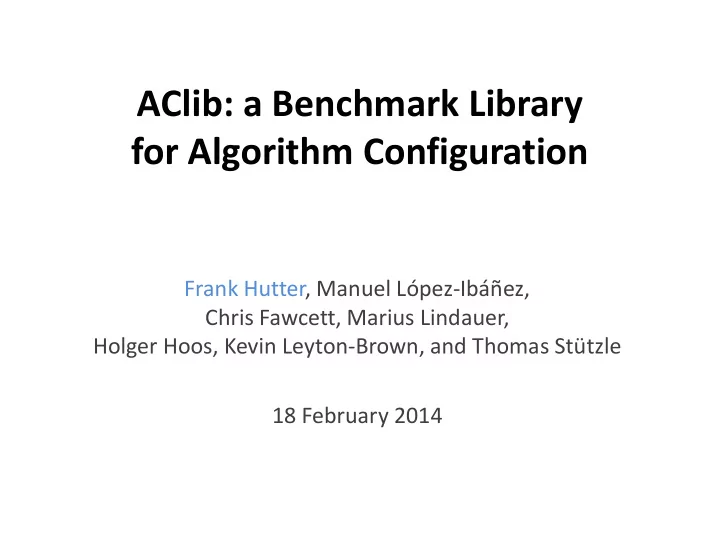

AClib: a Benchmark Library for Algorithm Configuration Frank Hutter, Manuel López-Ibáñez, Chris Fawcett, Marius Lindauer, Holger Hoos, Kevin Leyton-Brown, and Thomas Stützle 18 February 2014
Motivation • Most heuristic algorithms have free parameters – E.g. IBM ILOG CPLEX: 76 parameters • Preprocessing, underlying LP solver & its parameters, types of cuts, … • Algorithm configuration aims to find good parameter settings automatically – Eliminates most tedious part of algorithm design and end use – Saves development time & improves performance – Produces more reproducible research 2
Mainstream Adoption of AC Methods • Many different types of algorithms – Tree search, local search, metaheuristics, machine learning, … • Large improvements to solvers for many hard combinatorial problems – SAT, MIP, TSP, ASP, time-tabling, AI planning, … – Competition winners for all of these rely on configuration tools • Increasingly popular (citation numbers from Google scholar) ParamILS [Hutter et al.,'09] Iterated F-Race [Birattari et al., ‘10] GGA [Ansotegui et al, '09] SMAC [Hutter et al., ‘11] 3
Benefits of an AC Benchmark Library • Comparability & reproducibility – Easy access to broad range of standard benchmarks – Reduced effort for empirical evaluation – More meaningful results • Standardization of interfaces – Simplifies use of AC procedures – Speeds up development 4
The Algorithm Configuration Problem Definition – Given: • Runnable algorithm A with configuration space • Distribution D over problem instances Π • Performance metric – Find: Motivation Customize versatile algorithms for different application domains – Fully automated improvements – Optimize speed, accuracy, Very large space memory, energy consumption, … of configurations 5
The Algorithm Configuration Process 6
Methods for Algorithm Configuration Work on numerical parameter optimization (e.g., BBOB) – Evolutionary algorithms community, e.g ., CMA-ES [Hansen et al, '95-present] – Statistics & machine learning community, e.g., EGO [Jones et al, ‘98] , SPO [Bartz-Beielstein et al, ’05-present] Early work on categorical parameters – Composer [Gratch et al, '92 & '93] – Multi-TAC [Minton, '93] – F-Race [Birattari et al, ‘02] General algorithm configuration methods – Iterated Local Search, ParamILS [Hutter et al., '07 & '09] – Genetic algorithm, GGA [Ansotegui et al, '09] – Iterated F-Race [Birattari et al., ‘07-present] – Model-based Algorithm Configuration, SMAC [Hutter et al., '09-present] 7
Algo. Configuration vs. Blackbox Optimization Parameter types – Continuous, integer, ordinal – Categorical : finite domain, unordered, e.g., {a,b,c} – Conditional : only active for some instantiations of other parameters Optimization across a distribution of problem instances – Stochastic Optimization – Instances often differ widely in hardness Budget : CPU/wall time vs. # function evaluations – Overheads of configurator count! – Can exploit that fast function evaluations are cheaper – Can save time by cutting off slow runs early 8
AClib: Components • Configuration scenarios • For convenience, we also include configuration procedures – So far: ParamILS, SMAC, and Iterated F-Race 9
AClib: Design Criteria • Variety – Problems: decision & optimization problems, machine learning – Algorithm types: tree search, local search, machine learning – Number of parameters: 2 - 768 – Parameter types: continuous / discrete / conditional – Objectives: runtime to optimality / solution quality – Degree of homogeneity of instances • Assessing different configurator components – Search: which configuration to try next? – Racing/intensification: how many runs, which instances? – Capping: when to cut of a run? 10
AClib: Resolves Technical Challenges • Unified way to wrap target algorithms – Built-in control of CPU time & memory – Reliable measurements of CPU & wall time • No more need to rely on target algorithm’s time measurements • Consistent use of wall time / CPU time • Identical invocations of a target algorithm – Callstrings are independent of the configurator – Otherwise systematic biases possible, leading to incomparable results in the literature 11
AClib: Contribute • Contributing a benchmark scenario – Algorithm & its parameter description – Instances, Features, training/test split – CPU time & memory limits – Algoritm wrapper • Generates a call string given an instantiation of parameters • Parses the algorithm result • Contributing a configuration procedure – Accept scenarios in AClib format – Basically: call target algorithm on the command line and get results back 12
Future Work • For you: use AClib ;-) www.aclib.net • Ontology of algorithm configuration scenarios • Large-scale evaluation – Which configurator performs best on which types of problems? • Algorithm Configuration Evaluation – Planned as AAAI 2015 workshop (together with Yuri Malitsky) – Submit configuration scenarios! (same format as in AClib) – Submit configurators! 13
Recommend
More recommend